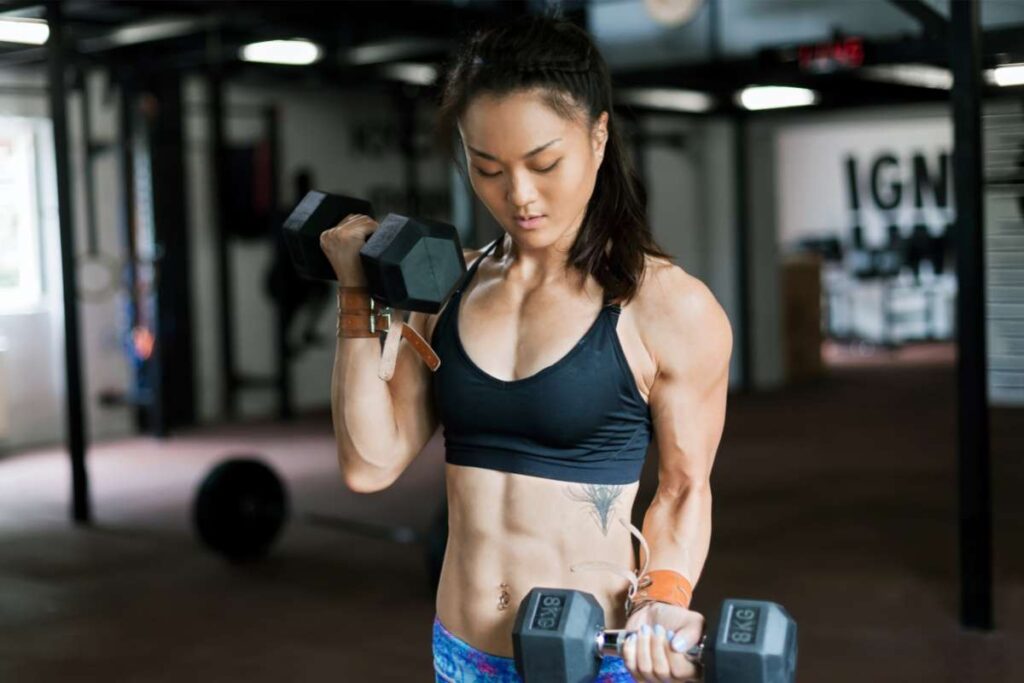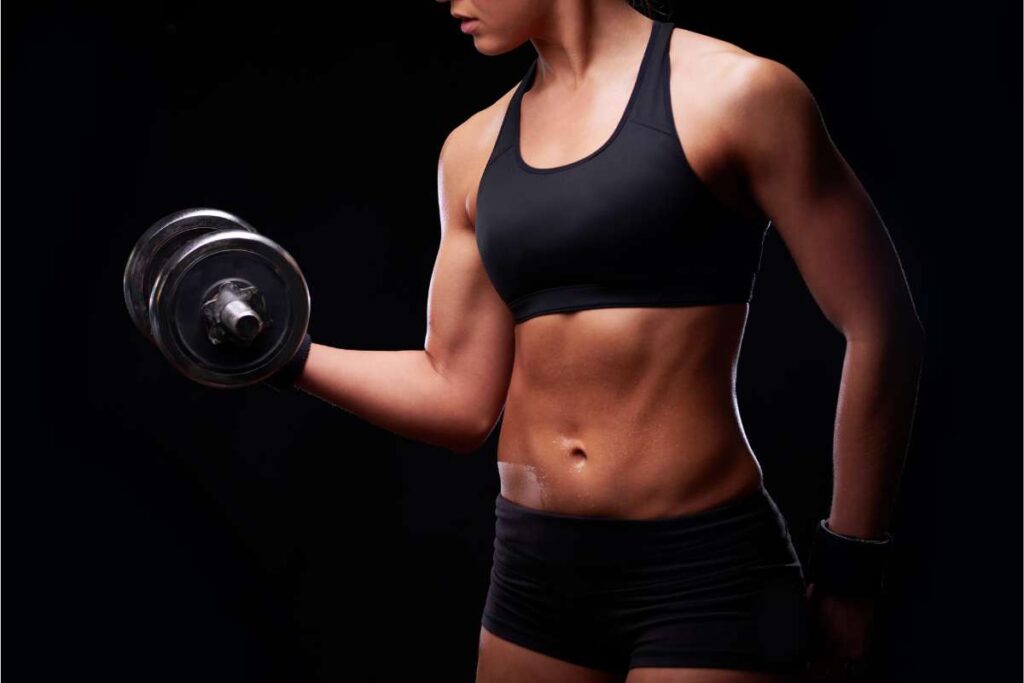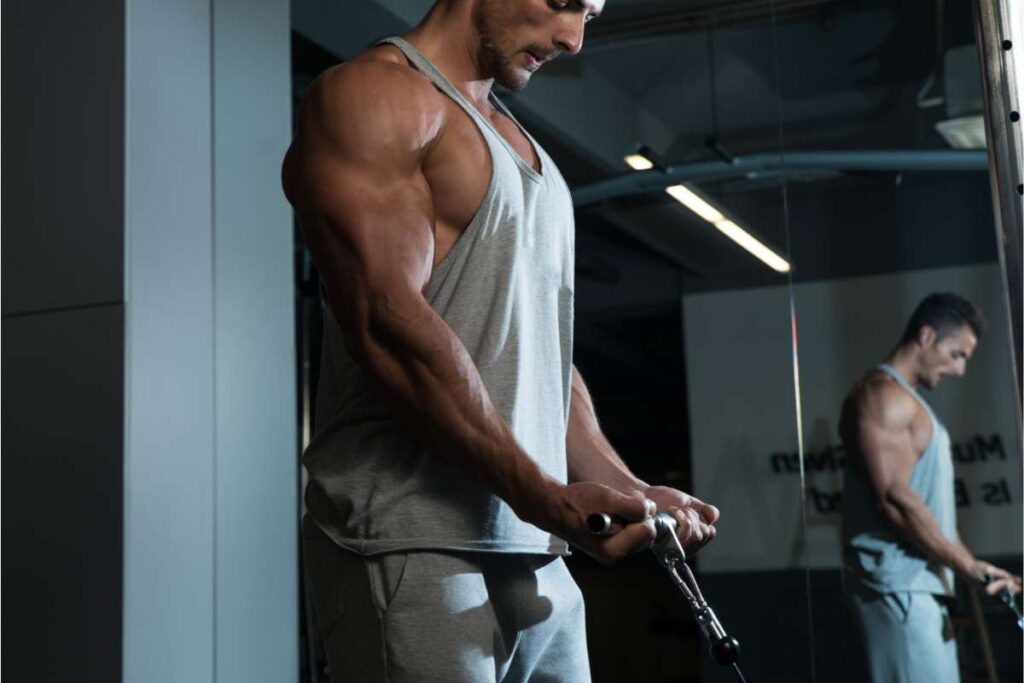This post may contain affiliate links at no additional cost to you. As an Amazon Associate I earn from qualifying purchases. Click to view our full disclosure.
What's inside
Do you have bad bicep genetics?
Having a hard time training your biceps is the best way to tell.
Maybe you’ve been hitting the gym for a while and despite all the countless hours curling, you just can’t seem to make them grow.
I get it. The high insertion, small peak, and lack of width are just demoralizing after months of training.
This is a complaint many of my clients have had over the years. It’s also something I have had great success helping people overcome.
Today, we will discuss bad bicep genetics, what they may look like, 8 exercises to increase your bicep peak, and pro tips to help you overcome the challenges.
Let’s dive in.
Do you have bad bicep genetics?
Bad bicep genetics may present as high bicep insertion, small bicep peak, smaller muscle bellies, and slower growth.
This is considered bad genetics as the biceps cover less surface area and are smaller in overall size. If you have some of these traits, you may have “bad” bicep genetics.
What is the average bicep size for men and women?
Related: Why Do I Have One Arm Bigger Than The Other?

Below is the average bicep size for men and women by age, based on data from the Centers for Disease Control and Prevention (CDC).
Disclaimer: This data is based on overall bicep size and not lean muscle mass.
| Age | Men | Women |
| 20-29 | 13.3” (33.8 cm) | 12.4” (31.5 cm) |
| 30-39 | 13.8” (35.1 cm) | 12.9” (32.8 cm) |
| 40-49 | 13.9” (35.3 cm) | 12.9” (32.8 cm) |
| 50-59 | 13.5” (34.3 cm) | 12.9” (32.8 cm) |
| 60-69 | 13.4” (34 cm) | 12.7” (32.3 cm) |
| 70-79 | 12.9” (32.8 cm) | 12.6” (32 cm) |
| 80+ | 12.1” (30.7 cm) | 11.4” (30 cm) |
Types of Biceps Genetics

Let’s talk about the specific ways your genetics may affect bicep appearance.
Short Biceps
Short biceps refers to the longer insertion point that sits at the lower end of the biceps.
This happens when the bicep converges into the tendon early, making the belly of your bicep seem shorter.
Long Biceps
Long biceps are when the belly of the bicep is longer and the tendon and insertion is much shorter.
This gives the appearance of a much larger bicep muscle as it sits across the length of the arm.
Small Peak
Small bicep peaks are when you flex your elbow and produce a small peak in the middle of the belly of your biceps.
While our peaks can vary in size, you can train to increase the size of your peak.
Narrow Biceps
Narrow biceps refers to the overall width of the bicep belly.
When we speak of biceps, we often think of mass in relation to height of the biceps. However, having narrow biceps or arms can really undermine your physique.
What is the meaning of bad bicep genetics?
Bad bicep genetics refers to biceps that won’t grow, have high insertion points, are narrower, or are uneven.
This makes the overall size and mass of the biceps appear smaller and flatter despite all of your training.
What are the main differences between good and bad bicep genetics?
Having bad bicep genetics can present in several different ways, and it doesn’t always mean you must suffer from every factor.
Here’s a list of the different factors for both good and bad biceps genetics to help compare and understand your anatomy better.
| Genetics | Good | Bad |
| Peak | Large | Small |
| Width | Wide | Narrow |
| Insertion | Low | High |
| Growth | Fast/Regular | Slow |
| Symmetry | Symmetrical | Asymmetrical |
How to Increase Biceps Peak: Try These 8 Exercises

Increasing the size of your bicep peak is about hitting both heads of the biceps and the brachialis that sits beneath it.
Here’s a list of the best exercises to get the job done.
1. Dumbbell Bicep Curls
The dumbbell bicep curls are staple for any bicep training workout.
When performed correctly in combination with different bicep exercises, this can be great for developing your bicep peak.
Equipment Requirements
- Dumbbells
How To Perform Dumbbell Bicep Curls
- Stand with a dumbbell in each hand resting at your sides in the neutral grip.
- Begin by lifting the dumbbell up toward your shoulders.
- Gradually rotate your wrists into an underhand grip as you curl the dumbbells.
- Curl the dumbbells until your knuckles are facing the ceiling.
- Lower back down to the starting position. Repeat.
Benefits
- Increase mass
- Improve physique
Pro Tips
- Focus on breathing and contracting your abs during your curls. This will minimize movement of the body and improve your ability to contact your biceps.
- When performing the bicep curl, concentrate on squeezing the head of the biceps at the top of the curl. This will improve your ability to target these muscle fibers.
2. Dumbbell Hammer Curls
Dumbbell hammer curls target the biceps, forearms, and brachialis. By improving mass for these three areas, you’ll increase your peak and improve overall physique.
Equipment Requirements
- Dumbbells
How To Perform Dumbbell Hammer Curls
- Stand holding a pair of dumbbells in the neutral grip by your sides.
- Start by curling the dumbbell up.
- Curl up until your fist is facing the ceiling.
- Once at the top, gradually lower the dumbbells back down to the beginning position. Repeat.
Benefits
- Targets forearms and brachialis
- Increase muscle mass
Pro Tips
- When performing the hammer curl, focus on contracting the biceps. This will improve activation and results.
- Focus on breathing, exhaling as you lift the dumbbells and inhaling as you lower.
3. Dumbbell Cross Body Curls
The dumbbell cross body curl targets the long head of the biceps, which is responsible for giving us our peak.
This helps us to directly target and train for a bigger bicep peak.
Equipment Requirements
- Dumbbells
How To Perform Dumbbell Cross Body Curls
- Stand upright holding a dumbbell in each hand at the side of your body.
- Using an underhand grip, curl the dumbbell up toward the midline of your body.
- Once it reaches the midline, lower it back to the starting position and alternate hands. Repeat.
Benefits
- Targets long head of biceps
- Increase peak
Pro Tips
- Begin with a lighter weight and focus on the contraction of the long head of biceps. This will improve your activation of these fibers and results.
- Focus on breathing for the duration of the movement, exhaling as you curl and inhaling as you release.
4. Incline Bicep Curls
The incline bicep curl is great for targeting the long head of biceps and developing our bicep peak.
Equipment Requirements
- Dumbbells
- Incline Bench
How To Perform Incline Bicep Curls
- Holding a pair of dumbbells, sit down on the incline bench.
- Lie back on the bench and allow your arms to hang down to your sides directly below your shoulders.
- Start by curling the dumbbells up toward your shoulders.
- Once the dumbbells meet the shoulders, gradually lower back down to the starting position. Repeat.
Benefits
- Targets long head of biceps
- Improves physique
Pro Tips
- If you are a beginner or you find the incline position uncomfortable, consider reducing the incline to 70 degrees. This will still allow for a great stretch of the bicep at full range.
- This movement can be uncomfortable for beginners, so when performing it for the first time, use a lighter weight.
5. Reverse Grip Chin-Ups
Reverse grip chin-ups are a great exercise for building our bicep peak since lifting your entire body weight requires a tremendous amount of strength.
The reverse grip in a narrow position is excellent for targeting the long head of the biceps.
Equipment Requirements
- Chin-Up Bar
How To Perform Reverse Grip Chin-Ups
- Stand directly beneath the chin-up bar.
- Reach overhead with a reverse grip and grab the bar.
- Begin the movement by pulling yourself up until your collarbone is in line with the bar.
- Once at the top, gradually lower back down to the starting position. Repeat.
Benefits
- Increase strength
- Increase muscle mass of biceps and back
Pro Tips
- When performing the reverse grip chin-up, focus on flexing your elbow and contracting your biceps. This will increase the intensity of the exercise. It may be difficult to do more reps, but it will give you great results.
- Keep your legs straight and core engaged for the duration of the movement. This will reduce any unwanted swinging, and help you focus on isolating the biceps.
6. Barbell Reverse Grip Curls
The barbell reverse grip curls are excellent for targeting the brachialis and the forearms.
The brachialis sits directly beneath the bicep. By increasing its size, you can greatly increase overall upper arm mass.
Equipment Requirements
- Barbell
How-To Perform Barbell Reverse Grip Curls
- Standing upright, hold the barbell in a reverse grip at shoulder-width apart.
- Begin by curling the barbell up toward your chest.
- Once the barbell reaches your chest, lower it back down to the starting position. Repeat.
Benefits
- Targets brachialis and forearms
- Contributes to bicep peak
Pro Tips
- The reverse grip is weaker movement, so consider performing the curl with a lighter weight.
- At the top of the movement focus on squeezing biceps. This will improve mind-muscle connection and improve activation.
7. Barbell Narrow Grip Curl
The barbell narrow grip curl is great for developing your bicep peak.
By positioning your hands in a narrow grip, you draw focus to the long head of the biceps on the lateral side of the arm.
Equipment Requirements
- Barbell
How To Perform Barbell Narrow Grip Curls
- Standing upright, hold a barbell in an underhand grip.
- Position your hands in the middle of the barbell so they are close to the midline of the body.
- Begin by curling the barbell up toward your collarbone.
- Once the barbell reaches the collarbone, slowly lower back down to the starting position. Repeat.
Benefits
- Target long head of biceps
- Improves physique
Pro Tips
- Begin with a lighter weight and focus on squeezing your biceps when you curl. This will help you feel and activate the fibers of the bicep peak.
- To improve muscle contraction and stability, brace core and exhale with every rep.
8. Preacher Curls
Preacher curls are a brilliant exercise for the bicep peak.
By putting your arm in the preacher position, you can isolate both the long and short head of the bicep, which will help you focus on contracting the muscle with every rep.
Equipment Requirements
- Preacher Curl
- EZ Bar
How To Perform Preacher Curls
- Sit down on the preacher curl with your arms resting on the padding.
- Grab the EZ bar with an underhand grip.
- Start by curling the barbell up toward your shoulders.
- Once your elbows are 70 degrees flexed, slowly lower the barbell back down. Repeat.
Benefits
- Isolates biceps
- Improve physique
Pro Tips
- When setting up, ensure that your weight is forward and your elbows are firmly placed on the padding. This will Improve your ability to isolate the biceps.
- When performing the preacher curl, do not fully extend the arm. This puts an immense amount of stress on the tendons and can result in ruptures if the weight is too heavy.
Related: 11 Top Long Head Bicep Exercises For Massive Peak
Pro Tips for Overcoming Bad Bicep Genetics
Related: From Skinny Twig Arms to Rock Solid Biceps, Fast!

Overcoming bad bicep genetics isn’t just about the exercise, but also how you approach your training.
Here are some practical ways to combat bad bicep genetics, including changes to your nutrition and your training habits.
Increase Calorie Intake
If you want to overcome bad bicep genetics and put on lean muscle, increasing your calorie intake should be first on your list.
To increase muscle mass, the body requires a calorie surplus.
Recommended calorie intake for males is 2,500 and 2,000 calories for women.
If we want to increase muscle mass, we recommend increasing this by 500 calories per day with nutrient-dense foods.
If you would like to find out your exact calorie intake, use this calorie calculator. It’ll give an exact calorie intake based on your gender, age, height, weight and activity level.
Once you use this, consider using a calorie tracking app like MyFitnessPal.
This will allow you to set your calorie and macro nutrient targets, which will also allow you to simply adjust your macros should you decide to increase your calories.
Increase Protein Intake
When you set out to overcome bad arm genetics, you need to be consuming enough protein.
Scientific research suggests that we should be consuming 1.6-2.2g of protein per kilogram of body weight.
This will help you build lean muscle mass and aid in your recovery.
Increase Volume
Increasing training volume has been linked to increasing muscle hypertrophy.
Studies have identified that by increasing the volume of your training of a specific muscle group, you can stimulate great growth.
To do this, consider training your arms two to three times per week.
This additional challenge will force the muscles to grow and adapt.
Progressive Overload
When we train to increase muscle mass, we need to progressively overload with each session.
Studies indicate that incremental increases to resistance, repetitions, and sets, which challenges our muscle to adapt and grow.
Final Thoughts
Bad bicep genetics can be frustrating to deal with. Countless hours in the gym with little growth can drive anyone mad.
However, even though you might have a high insertion point, or narrow muscle bellies, all hope is not lost.
By increasing your calorie and protein intake, as well as your training volume, you can get to guns to grow.
So, are you having difficulty with your bad bicep genetics? What changes will you make to get them to grow?
Let us know in the comments.
How do you know if you have bad bicep genetics?
If you struggle to increase muscle on your arms, you have a small bicep peak, or a high insertion point, you will likely have bad bicep genetics.
Is there a way to fix bad bicep genetics?
There are aspects of bad arm genetics that can not be changed, such as how your high bicep insertions are.
However, if you train consistently, focus on correct nutrition, and increase your training volume, you can overcome issues related to growth.
Is bicep shape genetic?
Yes, the shape of your biceps and their attachment points are genetic and can not be changed by lifting weights.
Are short biceps bad?
No. While many consider shorter biceps as bad genetics and less appealing to look at, they aren’t inherently bad.
They just lack a fuller shape that is preferred by most lifters.

